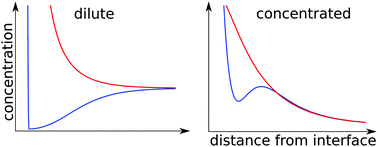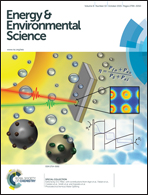A generalised space-charge theory for extended defects in oxygen-ion conducting electrolytes: from dilute to concentrated solid solutions†‡
Abstract
The standard Poisson–Boltzmann approach to modeling the near-interface defect behaviour in solid electrolytes performs well at low dopant concentrations but its applicability is questionable at higher dopant levels where interactions become important. Here we present a new approach, which combines Poisson–Boltzmann with the Cahn–Hilliard model for concentrated solid solutions. This ‘Poisson–Cahn’ theory yields activity coefficients for point defects that consider both local and non-local chemical interactions. Taking the fluorite-structured solid solution CeO2–Gd2O3 as a model system, we predict defect behaviour near grain boundaries over the entire concentration range. Examination of the near-interface defect-concentration and electrostatic-potential profiles reveals behaviour that matches existing space-charge theory at low overall dopant concentrations, becoming more complex, in accord with experiment and atomistic simulations, as concentrations increase. Inclusion of an existing conductivity model that considers the effects of local dopant concentration leads to the successful prediction of both bulk and total (bulk + grain boundary) conductivities in both concentrated and dilute cases. The Poisson–Cahn approach is not limited to grain boundaries in oxygen-ion conducting fluorite oxides, but is applicable to all extended defects—grain boundaries, surfaces and dislocations—in ion-conducting systems.



 Please wait while we load your content...
Please wait while we load your content...